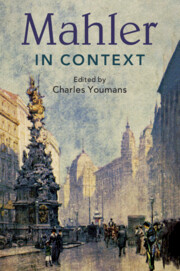Book contents
- Mahler in Context
- Composers in Context
- Mahler in Context
- Copyright page
- Dedication
- Contents
- Figures
- Music Examples
- Notes on Contributors
- Preface and Acknowledgments
- Abbreviations
- Part I Formation
- Part II Performance
- Chapter 8 Operatic and Orchestral Repertoire
- Chapter 9 Collaborators
- Chapter 10 A Perfect Storm
- Chapter 11 Celebrity
- Part III Creation
- Part IV Mind, Body, Spirit
- Part V Influence
- Further Reading
- Index
Chapter 9 - Collaborators
from Part II - Performance
Published online by Cambridge University Press: 18 December 2020
- Mahler in Context
- Composers in Context
- Mahler in Context
- Copyright page
- Dedication
- Contents
- Figures
- Music Examples
- Notes on Contributors
- Preface and Acknowledgments
- Abbreviations
- Part I Formation
- Part II Performance
- Chapter 8 Operatic and Orchestral Repertoire
- Chapter 9 Collaborators
- Chapter 10 A Perfect Storm
- Chapter 11 Celebrity
- Part III Creation
- Part IV Mind, Body, Spirit
- Part V Influence
- Further Reading
- Index
Summary
In spite of Mahler’s tyrannical bearing as an orchestral conductor, and his preference for composing in complete isolation, collaboration was in fact central to his success as a performing musician. In the realm of opera, it was collaboration that eventually enabled him to realize, in living form, his artistic aspirations and to create what we commonly think of today as the role of the modern opera director. The contributions of his collaborators in Vienna, above all the innovative graphic artist Alfred Roller (1864–1935), illustrate the areas in which Mahler relinquished his dictatorial control of operatic production, and the reasons that pushed him to this personally difficult step. Roller’s modernist reading of Wagnerian theory, informed by a belief that scenery and costumes should not fool the eye but rather “create the atmosphere of the drama,” made fundamental contributions to the style of production that became Mahler’s signature in Vienna.
- Type
- Chapter
- Information
- Mahler in Context , pp. 73 - 80Publisher: Cambridge University PressPrint publication year: 2020

